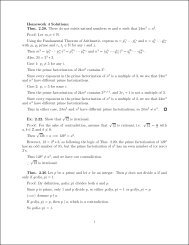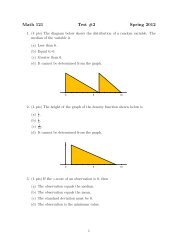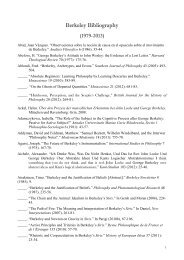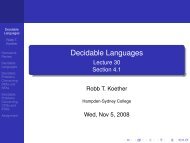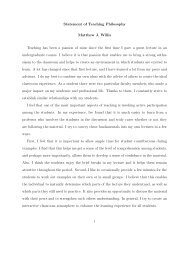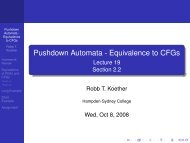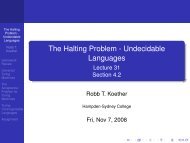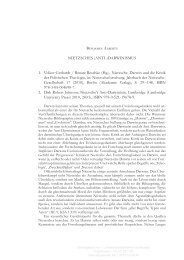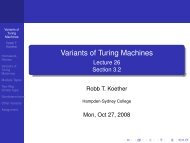Simple Random Sampling - Hampden-Sydney College
Simple Random Sampling - Hampden-Sydney College
Simple Random Sampling - Hampden-Sydney College
Create successful ePaper yourself
Turn your PDF publications into a flip-book with our unique Google optimized e-Paper software.
<strong>Simple</strong> <strong>Random</strong> <strong>Sampling</strong><br />
Lecture 7<br />
Section 2.5<br />
Robb T. Koether<br />
<strong>Hampden</strong>-<strong>Sydney</strong> <strong>College</strong><br />
Mon, Jan 30, 2012<br />
Robb T. Koether (<strong>Hampden</strong>-<strong>Sydney</strong> <strong>College</strong>) <strong>Simple</strong> <strong>Random</strong> <strong>Sampling</strong> Mon, Jan 30, 2012 1 / 28
Outline<br />
1 Introduction<br />
2 <strong>Simple</strong> <strong>Random</strong> Samples<br />
3 Selecting <strong>Simple</strong> <strong>Random</strong> Samples<br />
On the TI-83<br />
Setting the Seed<br />
4 Non-<strong>Simple</strong> <strong>Random</strong> Samples<br />
5 Assignment<br />
Robb T. Koether (<strong>Hampden</strong>-<strong>Sydney</strong> <strong>College</strong>) <strong>Simple</strong> <strong>Random</strong> <strong>Sampling</strong> Mon, Jan 30, 2012 2 / 28
Review Quiz<br />
Example (Review Quiz)<br />
1 Researchers select all the patients that are suffering from<br />
depression at a large hospital for their study.<br />
This could be an example of<br />
(a) Selection bias.<br />
(b) Non-response bias.<br />
(c) Response bias.<br />
(d) Experimenter bias.<br />
Robb T. Koether (<strong>Hampden</strong>-<strong>Sydney</strong> <strong>College</strong>) <strong>Simple</strong> <strong>Random</strong> <strong>Sampling</strong> Mon, Jan 30, 2012 3 / 28
Review Quiz<br />
Example (Review Quiz)<br />
2 Patients agree (or disagree) to be a part of a study to test the<br />
effectiveness of a new treatment.<br />
This could be an example of<br />
(a) Selection bias.<br />
(b) Non-response bias.<br />
(c) Response bias.<br />
(d) Experimenter bias.<br />
Robb T. Koether (<strong>Hampden</strong>-<strong>Sydney</strong> <strong>College</strong>) <strong>Simple</strong> <strong>Random</strong> <strong>Sampling</strong> Mon, Jan 30, 2012 4 / 28
Review Quiz<br />
Example (Review Quiz)<br />
3 Patients join either a treatment group that receives the new<br />
treatment and a control group that does not receive the treatment.<br />
This could be an example of<br />
(a) Selection bias.<br />
(b) Non-response bias.<br />
(c) Response bias.<br />
(d) Experimenter bias.<br />
Robb T. Koether (<strong>Hampden</strong>-<strong>Sydney</strong> <strong>College</strong>) <strong>Simple</strong> <strong>Random</strong> <strong>Sampling</strong> Mon, Jan 30, 2012 5 / 28
Review Quiz<br />
Example (Review Quiz)<br />
4 After two weeks, the researchers check each patient to see how<br />
well they are doing.<br />
This could be an example of<br />
(a) Selection bias.<br />
(b) Non-response bias.<br />
(c) Response bias.<br />
(d) Experimenter bias.<br />
Robb T. Koether (<strong>Hampden</strong>-<strong>Sydney</strong> <strong>College</strong>) <strong>Simple</strong> <strong>Random</strong> <strong>Sampling</strong> Mon, Jan 30, 2012 6 / 28
Review Quiz Answers<br />
Example (Review Quiz Answers)<br />
1. (a) Selection bias.<br />
2. (b) Non-response bias.<br />
3. (c) Response bias.<br />
4. (d) Experimenter bias.<br />
Robb T. Koether (<strong>Hampden</strong>-<strong>Sydney</strong> <strong>College</strong>) <strong>Simple</strong> <strong>Random</strong> <strong>Sampling</strong> Mon, Jan 30, 2012 7 / 28
Outline<br />
1 Introduction<br />
2 <strong>Simple</strong> <strong>Random</strong> Samples<br />
3 Selecting <strong>Simple</strong> <strong>Random</strong> Samples<br />
On the TI-83<br />
Setting the Seed<br />
4 Non-<strong>Simple</strong> <strong>Random</strong> Samples<br />
5 Assignment<br />
Robb T. Koether (<strong>Hampden</strong>-<strong>Sydney</strong> <strong>College</strong>) <strong>Simple</strong> <strong>Random</strong> <strong>Sampling</strong> Mon, Jan 30, 2012 8 / 28
Introduction<br />
Suppose I wanted to select a random sample of 4 students from<br />
this class.<br />
Robb T. Koether (<strong>Hampden</strong>-<strong>Sydney</strong> <strong>College</strong>) <strong>Simple</strong> <strong>Random</strong> <strong>Sampling</strong> Mon, Jan 30, 2012 9 / 28
Introduction<br />
Suppose I wanted to select a random sample of 4 students from<br />
this class.<br />
I start in the front left corner and toss a coin.<br />
Heads, that student is selected.<br />
Tails, he is not selected.<br />
Robb T. Koether (<strong>Hampden</strong>-<strong>Sydney</strong> <strong>College</strong>) <strong>Simple</strong> <strong>Random</strong> <strong>Sampling</strong> Mon, Jan 30, 2012 9 / 28
Introduction<br />
Suppose I wanted to select a random sample of 4 students from<br />
this class.<br />
I start in the front left corner and toss a coin.<br />
Heads, that student is selected.<br />
Tails, he is not selected.<br />
I move on to the next student behind him and use the same rule.<br />
Robb T. Koether (<strong>Hampden</strong>-<strong>Sydney</strong> <strong>College</strong>) <strong>Simple</strong> <strong>Random</strong> <strong>Sampling</strong> Mon, Jan 30, 2012 9 / 28
Introduction<br />
Suppose I wanted to select a random sample of 4 students from<br />
this class.<br />
I start in the front left corner and toss a coin.<br />
Heads, that student is selected.<br />
Tails, he is not selected.<br />
I move on to the next student behind him and use the same rule.<br />
I continue in this manner, row by row, until I have 4 students.<br />
Robb T. Koether (<strong>Hampden</strong>-<strong>Sydney</strong> <strong>College</strong>) <strong>Simple</strong> <strong>Random</strong> <strong>Sampling</strong> Mon, Jan 30, 2012 9 / 28
Introduction<br />
Suppose I wanted to select a random sample of 4 students from<br />
this class.<br />
I start in the front left corner and toss a coin.<br />
Heads, that student is selected.<br />
Tails, he is not selected.<br />
I move on to the next student behind him and use the same rule.<br />
I continue in this manner, row by row, until I have 4 students.<br />
Is the sample a random sample<br />
Robb T. Koether (<strong>Hampden</strong>-<strong>Sydney</strong> <strong>College</strong>) <strong>Simple</strong> <strong>Random</strong> <strong>Sampling</strong> Mon, Jan 30, 2012 9 / 28
Introduction<br />
Suppose I wanted to select a random sample of 4 students from<br />
this class.<br />
I start in the front left corner and toss a coin.<br />
Heads, that student is selected.<br />
Tails, he is not selected.<br />
I move on to the next student behind him and use the same rule.<br />
I continue in this manner, row by row, until I have 4 students.<br />
Is the sample a random sample<br />
Is this a good method<br />
Robb T. Koether (<strong>Hampden</strong>-<strong>Sydney</strong> <strong>College</strong>) <strong>Simple</strong> <strong>Random</strong> <strong>Sampling</strong> Mon, Jan 30, 2012 9 / 28
Outline<br />
1 Introduction<br />
2 <strong>Simple</strong> <strong>Random</strong> Samples<br />
3 Selecting <strong>Simple</strong> <strong>Random</strong> Samples<br />
On the TI-83<br />
Setting the Seed<br />
4 Non-<strong>Simple</strong> <strong>Random</strong> Samples<br />
5 Assignment<br />
Robb T. Koether (<strong>Hampden</strong>-<strong>Sydney</strong> <strong>College</strong>) <strong>Simple</strong> <strong>Random</strong> <strong>Sampling</strong> Mon, Jan 30, 2012 10 / 28
<strong>Simple</strong> <strong>Random</strong> Sample<br />
Definition (<strong>Simple</strong> random sample)<br />
A simple random sample of size n is a random sample that is selected<br />
in such a way that all samples of size n have the same chance of being<br />
selected.<br />
Robb T. Koether (<strong>Hampden</strong>-<strong>Sydney</strong> <strong>College</strong>) <strong>Simple</strong> <strong>Random</strong> <strong>Sampling</strong> Mon, Jan 30, 2012 11 / 28
<strong>Simple</strong> <strong>Random</strong> Sample<br />
A consequence of this is that all individuals in the population have<br />
the same chance of being selected for the sample.<br />
Robb T. Koether (<strong>Hampden</strong>-<strong>Sydney</strong> <strong>College</strong>) <strong>Simple</strong> <strong>Random</strong> <strong>Sampling</strong> Mon, Jan 30, 2012 12 / 28
<strong>Simple</strong> <strong>Random</strong> Sample<br />
Example (<strong>Simple</strong> <strong>Random</strong> Sample)<br />
For example, let the population be {Armstrong, Bean, Craycroft,<br />
Davis, Freston, Garner}.<br />
The possible samples of size 3 are<br />
{A, B, C} {A, C, D} {A, D, G} {B, C, G} {C, D, F}<br />
{A, B, D} {A, C, F} {A, F, G} {B, D, F} {C, D, G}<br />
{A, B, F} {A, C, G} {B, C, D} {B, D, G} {C, F, G}<br />
{A, B, G} {A, D, F} {B, C, F} {B, F, G} {D, F, G}<br />
Choose one of the above samples at random.<br />
What is each person’s chance of being in the sample<br />
Robb T. Koether (<strong>Hampden</strong>-<strong>Sydney</strong> <strong>College</strong>) <strong>Simple</strong> <strong>Random</strong> <strong>Sampling</strong> Mon, Jan 30, 2012 13 / 28
Outline<br />
1 Introduction<br />
2 <strong>Simple</strong> <strong>Random</strong> Samples<br />
3 Selecting <strong>Simple</strong> <strong>Random</strong> Samples<br />
On the TI-83<br />
Setting the Seed<br />
4 Non-<strong>Simple</strong> <strong>Random</strong> Samples<br />
5 Assignment<br />
Robb T. Koether (<strong>Hampden</strong>-<strong>Sydney</strong> <strong>College</strong>) <strong>Simple</strong> <strong>Random</strong> <strong>Sampling</strong> Mon, Jan 30, 2012 14 / 28
<strong>Simple</strong> <strong>Random</strong> Sample<br />
For larger populations, the previous method is not practical.<br />
For example, if N = 100 and n = 6, then there are 1,192,052,400<br />
different possible samples.<br />
However, it turns out that if we select individuals one at a time,<br />
with all individuals equally likely at each step, then all samples are<br />
equally likely.<br />
Thus, our sample will be a simple random sample.<br />
Robb T. Koether (<strong>Hampden</strong>-<strong>Sydney</strong> <strong>College</strong>) <strong>Simple</strong> <strong>Random</strong> <strong>Sampling</strong> Mon, Jan 30, 2012 15 / 28
Selecting a <strong>Simple</strong> <strong>Random</strong> Sample<br />
Select a Sample of Size n<br />
Given a population of size N,<br />
Number the members of the population from 1 to N.<br />
Use a random number generator (such as on a calculator) to<br />
generate n random integers from 1 to N.<br />
Robb T. Koether (<strong>Hampden</strong>-<strong>Sydney</strong> <strong>College</strong>) <strong>Simple</strong> <strong>Random</strong> <strong>Sampling</strong> Mon, Jan 30, 2012 16 / 28
<strong>Sampling</strong> With or Without Replacement<br />
Definition (<strong>Sampling</strong> with replacement)<br />
When we sample with replacement, a selected item may be selected<br />
again. That is, repetitions are allowed.<br />
Definition (<strong>Sampling</strong> without replacement)<br />
When we sample without replacement, a selected item may not be<br />
selected again. That is, repetitions are not allowed.<br />
<strong>Sampling</strong> may be done with or without replacement.<br />
Robb T. Koether (<strong>Hampden</strong>-<strong>Sydney</strong> <strong>College</strong>) <strong>Simple</strong> <strong>Random</strong> <strong>Sampling</strong> Mon, Jan 30, 2012 17 / 28
Outline<br />
1 Introduction<br />
2 <strong>Simple</strong> <strong>Random</strong> Samples<br />
3 Selecting <strong>Simple</strong> <strong>Random</strong> Samples<br />
On the TI-83<br />
Setting the Seed<br />
4 Non-<strong>Simple</strong> <strong>Random</strong> Samples<br />
5 Assignment<br />
Robb T. Koether (<strong>Hampden</strong>-<strong>Sydney</strong> <strong>College</strong>) <strong>Simple</strong> <strong>Random</strong> <strong>Sampling</strong> Mon, Jan 30, 2012 18 / 28
TI-83: Selecting a Sample<br />
TI-83: Selecting a Sample<br />
1 Press MATH.<br />
2 Use the arrow keys to highlight the PRB menu title.<br />
3 Press 5 to select randInt (item #5).<br />
4 Enter randInt(1,100). (E.g., if N = 100.)<br />
5 Press ENTER. A random number appears.<br />
6 Press ENTER repeatedly for more random numbers.<br />
If the sampling is done without replacement, then repetitions<br />
should be discarded.<br />
Robb T. Koether (<strong>Hampden</strong>-<strong>Sydney</strong> <strong>College</strong>) <strong>Simple</strong> <strong>Random</strong> <strong>Sampling</strong> Mon, Jan 30, 2012 19 / 28
Example<br />
Let the population be the students in this class.<br />
Then N = 18.<br />
Number the members 1 - 18 in alphabetical order.<br />
We will choose a sample of size n = 6.<br />
What is each individual’s chance of being in the sample<br />
Practice<br />
Use randInt(1,18) to select 6 students.<br />
Robb T. Koether (<strong>Hampden</strong>-<strong>Sydney</strong> <strong>College</strong>) <strong>Simple</strong> <strong>Random</strong> <strong>Sampling</strong> Mon, Jan 30, 2012 20 / 28
TI-83: Getting a Set of <strong>Random</strong> Numbers<br />
To get several random integers at once, possibly with repetitions,<br />
use randInt with a third parameter, representing the sample<br />
size.<br />
For example, to get 6 random integers from 1 to 18, enter<br />
randInt(1,18,6).<br />
However, this may include repetitions.<br />
Robb T. Koether (<strong>Hampden</strong>-<strong>Sydney</strong> <strong>College</strong>) <strong>Simple</strong> <strong>Random</strong> <strong>Sampling</strong> Mon, Jan 30, 2012 21 / 28
Outline<br />
1 Introduction<br />
2 <strong>Simple</strong> <strong>Random</strong> Samples<br />
3 Selecting <strong>Simple</strong> <strong>Random</strong> Samples<br />
On the TI-83<br />
Setting the Seed<br />
4 Non-<strong>Simple</strong> <strong>Random</strong> Samples<br />
5 Assignment<br />
Robb T. Koether (<strong>Hampden</strong>-<strong>Sydney</strong> <strong>College</strong>) <strong>Simple</strong> <strong>Random</strong> <strong>Sampling</strong> Mon, Jan 30, 2012 22 / 28
TI-83: Setting the Seed<br />
TI-83: Setting the Seed<br />
1 Enter a seed (choose any number whatsoever).<br />
2 Press STO. An arrow appears in the display.<br />
3 Press MATH, highlight PRB, select rand (item #1).<br />
4 Press ENTER. The seed is now set.<br />
In general practice, this is not done.<br />
We do it only to “synchronize” our calculators so that we will all get<br />
the same answer.<br />
Robb T. Koether (<strong>Hampden</strong>-<strong>Sydney</strong> <strong>College</strong>) <strong>Simple</strong> <strong>Random</strong> <strong>Sampling</strong> Mon, Jan 30, 2012 23 / 28
Practice<br />
Practice<br />
Set the seed to 157 (an arbitrary choice).<br />
Then select a random sample of size 6 from the population of the<br />
students in this class.<br />
Robb T. Koether (<strong>Hampden</strong>-<strong>Sydney</strong> <strong>College</strong>) <strong>Simple</strong> <strong>Random</strong> <strong>Sampling</strong> Mon, Jan 30, 2012 24 / 28
Outline<br />
1 Introduction<br />
2 <strong>Simple</strong> <strong>Random</strong> Samples<br />
3 Selecting <strong>Simple</strong> <strong>Random</strong> Samples<br />
On the TI-83<br />
Setting the Seed<br />
4 Non-<strong>Simple</strong> <strong>Random</strong> Samples<br />
5 Assignment<br />
Robb T. Koether (<strong>Hampden</strong>-<strong>Sydney</strong> <strong>College</strong>) <strong>Simple</strong> <strong>Random</strong> <strong>Sampling</strong> Mon, Jan 30, 2012 25 / 28
<strong>Simple</strong> <strong>Random</strong> Sample<br />
Example (<strong>Simple</strong> <strong>Random</strong> Sample)<br />
Just because a sampling method guarantees that all individuals in<br />
the population have the same chance of being in the sample, it<br />
does not mean that the sample is a simple random sample.<br />
For example, suppose we toss a coin to choose one of the<br />
following samples.<br />
{A, B, C} {D, F, G}<br />
Robb T. Koether (<strong>Hampden</strong>-<strong>Sydney</strong> <strong>College</strong>) <strong>Simple</strong> <strong>Random</strong> <strong>Sampling</strong> Mon, Jan 30, 2012 26 / 28
<strong>Simple</strong> <strong>Random</strong> Sample<br />
Example (<strong>Simple</strong> <strong>Random</strong> Sample)<br />
Just because a sampling method guarantees that all individuals in<br />
the population have the same chance of being in the sample, it<br />
does not mean that the sample is a simple random sample.<br />
For example, suppose we toss a coin to choose one of the<br />
following samples.<br />
{A, B, C} {D, F, G}<br />
What is each person’s chance of being in the sample<br />
Robb T. Koether (<strong>Hampden</strong>-<strong>Sydney</strong> <strong>College</strong>) <strong>Simple</strong> <strong>Random</strong> <strong>Sampling</strong> Mon, Jan 30, 2012 26 / 28
<strong>Simple</strong> <strong>Random</strong> Sample<br />
Example (<strong>Simple</strong> <strong>Random</strong> Sample)<br />
Just because a sampling method guarantees that all individuals in<br />
the population have the same chance of being in the sample, it<br />
does not mean that the sample is a simple random sample.<br />
For example, suppose we toss a coin to choose one of the<br />
following samples.<br />
{A, B, C} {D, F, G}<br />
What is each person’s chance of being in the sample<br />
What is the probability of getting the sample {A,B,C}<br />
Robb T. Koether (<strong>Hampden</strong>-<strong>Sydney</strong> <strong>College</strong>) <strong>Simple</strong> <strong>Random</strong> <strong>Sampling</strong> Mon, Jan 30, 2012 26 / 28
<strong>Simple</strong> <strong>Random</strong> Sample<br />
Example (<strong>Simple</strong> <strong>Random</strong> Sample)<br />
Just because a sampling method guarantees that all individuals in<br />
the population have the same chance of being in the sample, it<br />
does not mean that the sample is a simple random sample.<br />
For example, suppose we toss a coin to choose one of the<br />
following samples.<br />
{A, B, C} {D, F, G}<br />
What is each person’s chance of being in the sample<br />
What is the probability of getting the sample {A,B,C}<br />
What is the probability of getting the sample {A,B,D}<br />
Robb T. Koether (<strong>Hampden</strong>-<strong>Sydney</strong> <strong>College</strong>) <strong>Simple</strong> <strong>Random</strong> <strong>Sampling</strong> Mon, Jan 30, 2012 26 / 28
Outline<br />
1 Introduction<br />
2 <strong>Simple</strong> <strong>Random</strong> Samples<br />
3 Selecting <strong>Simple</strong> <strong>Random</strong> Samples<br />
On the TI-83<br />
Setting the Seed<br />
4 Non-<strong>Simple</strong> <strong>Random</strong> Samples<br />
5 Assignment<br />
Robb T. Koether (<strong>Hampden</strong>-<strong>Sydney</strong> <strong>College</strong>) <strong>Simple</strong> <strong>Random</strong> <strong>Sampling</strong> Mon, Jan 30, 2012 27 / 28
Assignment<br />
Homework<br />
Read Section 2.5, pages 98 - 106.<br />
Let’s Do It! 2.4.<br />
Page 107, exercises 13, 15 - 18.<br />
Robb T. Koether (<strong>Hampden</strong>-<strong>Sydney</strong> <strong>College</strong>) <strong>Simple</strong> <strong>Random</strong> <strong>Sampling</strong> Mon, Jan 30, 2012 28 / 28



